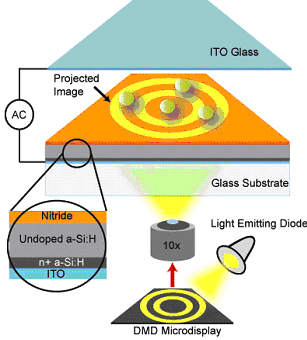Researchers: Aaron T. Ohta, Arash Jamshidi, Hsan-Yin Hsu, Justin K. Valley, Steven L. Neale
Funding Agencies: NIH, DARPA, NASA through CMISE

Figure 1: Device structure used in optoelectronic tweezers (OET). Liquid that contains microscopic particles is sandwiched between the top ITO glass and the bottom photosensitive surface consisting of ITO-coated glass topped with multiple featureless layers: heavily doped a-Si:H, undoped a-Si:H, and silicon nitride. The top and bottom surfaces are biased with an AC electric signal. The illumination source is an LED operating at a wavelength of 625 nm (Lumileds, Luxeon Star/O). The optical images shown on the digital micromirror display (DMD) are focused onto the photosensitive surface and create the non-uniform electric field for DEP manipulation.
The goal of this project is to develop a non-invasive, low-power, parallel optical manipulation tool for
trapping, transporting, and sorting cells, microparticles, and nanoparticles. Optoelectronic tweezers (OET) enables optically-controlled cellular manipulation with optical power densities 100,000 times less than optical tweezers. The low power requirement enables the use of direct imaging and incoherent light (from a single LED or a halogen lamp) to create optical manipulation patterns in real-time. We have successfully used a digital micromirror display (DMD) spatial light modulator and an LED to create 15,000 individually addressable optical traps over an area of 1.3 mm x 1.0 mm. The OET can be combined with microvision tools to perform particle or cell sorting based on luminescence, size, texture or other visual attributes of the particles.
The working principle behind optoelectronic tweezers is light-induced dielectrophoresis. A photosensitive device layer forms “virtual electrodes” upon exposure to light, creating non uniformities in an applied electric field (Fig. 1). The non-uniform electric field gives rise to a force known as dielectrophoresis: micro- and nanoparticles move as a result of the non-uniformities in the electric field imparting unequal forces on the induced dipole of the particle.
Press Coverage
